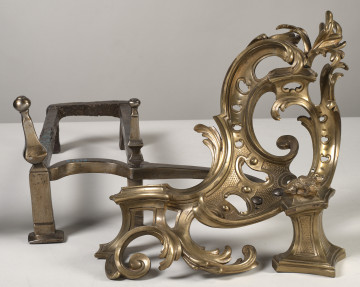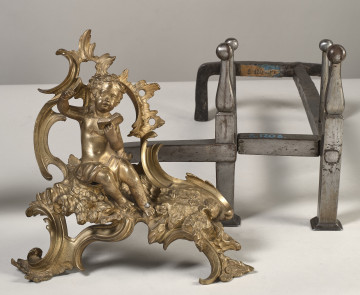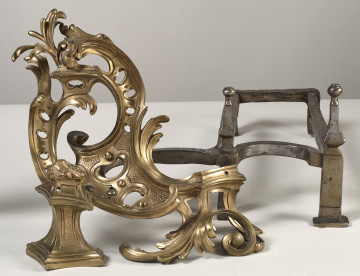
Fireplace wolf
18th century
Castle Museum in Łańcut
Part of the collection: Metale
Andiron The history of andirons, or firedogs, began in the Middle Ages, their prototype was a long rod of wrought iron with a hook for hanging a cauldron over a fire. In the 14th century, this bar was augmented by a shaft running deep into the hearth to support wooden logs, and from the 16th century on, a decorative function was added to the utilitarian function. The name “firedog” (in Poland the name “chimney wolf” was adopted) comes from English and French. The most common material used for firedogs was wrought iron, although in the late 17th century, silver and later bronze, often gilded, were common. The forms of the andirons changed with the current fashion and style, from very simple to very decorative. The andiron in question comes from the Potocki collection, from the second half of the 18th century, in the style of Louis XVI. The andiron has a decorative part, consisting of an amphora connected to an elongated, profiled beam, ending in a figure of a seated griffin, facing the hearth. The bar with the griffin rests on a base ending in a semicircle. The space between the beam and the base is filled with an openwork vine ornament with fruit. A flamboyant amphora, on a circular foot, with a pedestal and a garland of vine leaves and grapes passing through the handles, falling to the body. The amphora is additionally decorated with a vine ornament. A French product, bronze, andiron consisting of a rectangular-shaped grate on four legs (the rear legs are arched, the front legs have decorative pinnacles) with additional decoration in the form of rods ending in knobs. The decorative part is made of bronze in the form of a large rocaille with a seated putto in the centre in a relaxed pose, the additional decoration is made of clusters of field flowers. Decorated on the front with pinnacles, the decorative part in bronze in the form of a large rocaille and acanthus leaves.
Author / creator
Dimensions
height: 29 cm, width: 36 cm
Object type
Metals
Technique
cast, forging
Material
iron, brass
Creation time / dating
Creation / finding place
Owner
Castle Museum in Łańcut
Identification number
Location / status

18th century
Castle Museum in Łańcut

19th (?) century
Castle Museum in Łańcut

18th century
Castle Museum in Łańcut
DISCOVER this TOPIC
Museum of King Jan III's Palace at Wilanów
DISCOVER this PATH
Educational path